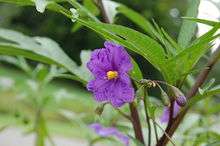Solanum laciniatum
Solanum laciniatum is a soft-wooded shrub native to the east coast of Australia, notably Victoria and Tasmania. It also occurs in Western Australia[1] and New Zealand, where some authorities consider it to be introduced. It is similar to Solanum aviculare, with which it shares the common name kangaroo apple. The common name refers to the likeness of the leaf shape to a kangaroo paw print. This plant is currently being cultivated to produce corticosteroid drugs.[2]
| Solanum laciniatum | |
|---|---|
 | |
| Scientific classification | |
| Kingdom: | Plantae |
| Clade: | Tracheophytes |
| Clade: | Angiosperms |
| Clade: | Eudicots |
| Clade: | Asterids |
| Order: | Solanales |
| Family: | Solanaceae |
| Genus: | Solanum |
| Species: | S. laciniatum |
| Binomial name | |
| Solanum laciniatum | |
| Synonyms | |
| |
Description
The shrub typically grows to a height and width of 1 to 3 m (3 ft 3 in to 9 ft 10 in) and blooms between January and February producing purple blue flowers.[1]
Habitat
Grows in well-drained soils in full sun or partial shade. Tolerates moderately salty winds. Is very fast growing but short lived. Solanum laciniatum often colonises disturbed soil and tracks.[2]
Images
 Foliage
Foliage Fruit
Fruit
References
- "Solanum laciniatum". FloraBase. Western Australian Government Department of Parks and Wildlife.
- Scott, Rob; Blake, Neil; Campbell, Jeannie; Evans, Doug; Williams, Nicholas (2002). Indigenous Plants of the Sandbelt. St Kilda: Earthcare. p. 124. ISBN 0 9581009 0 X.
External links

